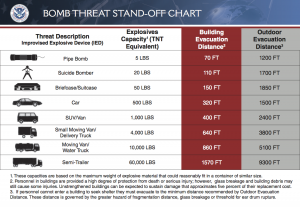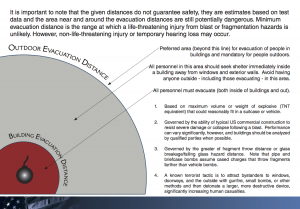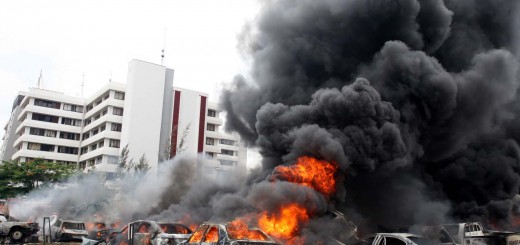Effects of Improvised Explosive Devices (IED’s)
The extent of damage caused by an IED depends on its size, construction, and placement, and whether it incorporates a high explosive or propellant. Vehicle bombs, also know as vehicle-borne IEDs, can carry significantly more explosive material, and therefore do more damage.
Damage to structures and to Infrastructure
An explosion in or near a building or public transportation venue may blow out windows; destroy walls; and shut down building systems such as power, ventilation, fire suppression, water/sewage, and others. Exit routes may be disrupted or destroyed, and smoke and dust may travel upward through stair-ways and elevator shafts, making navigation difficult. Building failure may result in the release of hazardous materials used within a building, such as radioactive material from medical devices, or incorporated within the structure of a building, such as asbestos insulation. An IED attack may cause disruptions in municipal services such as electricity, water, communications, and transportation, which may continue for days to weeks after the attack. Individuals and businesses should have a plan for addressing these interruptions.
The Possibility of secondary Devices and/or Multiple Explosions
A known bomber tactic is to use a distraction, such as gunfire, small bombs, or other surprises, to attract bystanders to a window, a doorway, or outside, and then to detonate a second destructive device at the gathering point. In an attack, there may be bombings at multiple locations. rescue efforts can be hampered by the need to respond to more than one site.
Secondary hazards
The explosion of a bomb can cause secondary explosions if gasoline, natural gas, or other flammable material is ignited. secondary hazards that result can include fire with possibly toxic smoke, disruption of electric power, ruptured natural gas lines and water mains, and debris. there can be loss of traffic control in the area of the blast with possible traffic accidents involving fleeing citizens.
Immediate health Effects
Explosions create a high-pressure blast that sends debris flying and lifts people off the ground. the type of injuries and the number of people hurt will vary depending on: the physical environment and the size of the blast; the amount of shielding between victims and the blast; fires, or structural damage that result from the explosion; and whether the explosion occurs in a closed space or an open area. Injuries common to explosions include:
Overpressure damage to the lungs, ears, abdomen, and other pressure-sensitive organs. Blast lung injury, a condition caused by the extreme pressure of an explosion, is the leading cause of illness and death for initial survivors of an explosion. Fragmentation injuries caused by projectiles thrown by the blast – material from the bomb, shrapnel, or flying debris that penetrates the body and causes damage. Impact injuries caused when the blast throws a victim into another object, i.e. fractures, amputation, and trauma to the head and neck. Thermal injuries caused by burns to the skin, mouth, sinus, and lungs.
other injuries including exposure to toxic substances, crush injuries, and aggravation of pre-existing conditions (asthma, congestive heart failure, etc.).
Delayed Health Effects
some health effects caused by IEDs, including eye injuries and abdominal injuries, may not be apparent initially, but can cause symptoms and even fatalities hours to months after the event. psychological effects in attack survivors, first responders, and others are not unusual in the after-math of a high-casualty event. While most symptoms diminish with time, in some cases assistance and guidance from mental health professionals may be required.
IED Evacuation Ranges
Understanding The Times: Exposition on Anti-Terrorism Strategies by Fela Dada







Recent Comments